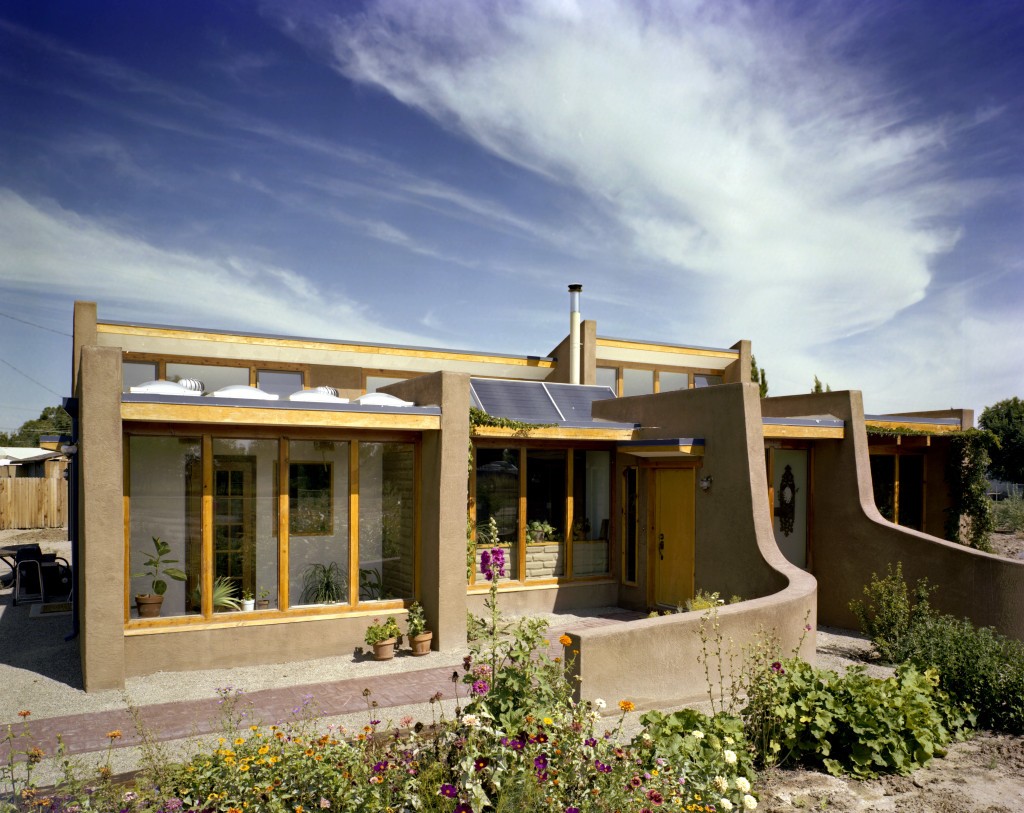
A passive solar home utilizes the winter sun for heating and keeps the summer sun out when heat isn’t needed. Natural day lighting is enjoyed year-round in a well designed passive solar home. This is achieved by designing the home with proper site orientation, floor plan layout, window placement and overhang (or other shading) design. There are no moving parts or mechanical systems in passive solar design.
A passive solar home does not have to be more expensive than a traditionally designed home. All it takes to harness the sun for wonderful natural light and energy efficiency is designing the home with respect to solar motion. Every home needs windows, and these windows are typically the primary source of energy loss. By designing a home with passive solar strategies in mind, it is possible to create spaces that are bright and cheery with lots of windows and great views while simultaneously using less energy. When this is done well, these spaces have the perfect amount of daylighting to feel comfortable inside, throughout the year.
Passive solar homes have a synergistic relationship with their environment. If you are building a new home it is critical to consider how this strategy might be implemented. Not every home can or should be passive solar, and some situations such as a house on the north side of a steep hill or a home in a temperate climate preclude this option. With a bit of creativity, however, most new homes in North America can be designed and built to utilize passive solar concepts to some degree to bring in natural light and reduce heating bills.
So How Does It Work?
Passive solar design is based on an understanding of how the sun moves through the sky at different times of the year. In winter in North America, the sun tracks lower in the southern sky and in summer it tracks higher. A passive solar home takes advantage of this difference in sun angles from season to season. By orienting the home correctly and using roof overhangs and other shading devices, a passive solar design is able to allow sun into the home in the winter when the solar heat is desirable and shade itself from the the sun in the summer.
Thermal Mass
Thermal mass refers to the use of high density materials such as masonry or water to store solar heat during the day and release it at night, in order to minimize temperature fluctuations. Depending on the amount of solar heat you hope to gain through passive solar design, it may or may not be necessary to introduce additional thermal mass into a home. A passive solar home typically orients its long axis east/west to maximize the amount of south facing exterior wall. The extent to which a home captures passive solar heat is expressed as a percentage of south facing window area to heated floor area. As a general rule, a house with a ratio of 7% or less south facing glazing to floor area is considered “sun tempered” and does not require any additional thermal mass beyond what is typically present in a home. As this ratio is increased, so is the amount of solar heat. Without additional thermal mass to absorb this extra heat, the house could actually overheat during the day. At night, these large windows shed heat to the outside making the house uncomfortably cold. Thermal mass essentially acts like a heat battery that is charged by the sun during the day and is discharged at night. This minimizes the temperature fluctuations from day to night and allows a home to utilize more solar energy. The amount of thermal mass required depends on the ratio of floor area to south glazing and the higher the ratio, the more thermal mass needed.
One of the easiest sources of thermal mass is an exposed or tiled concrete slab. There are many other ways of increasing the thermal mass in a home. Thermal mass can be a fun design opportunity and can lead to some creative and interesting architectural solutions. If you want to heat your home mostly by the sun, the inclusion of thermal mass is an important consideration.
Trombe Walls

Old style passive solar houses were often designed with Trombe (pronounced trawm) walls, which are interior south-facing, solid masonry walls built about 6-18 inches from south facing windows. Trombe walls are a great source of thermal mass and absorb solar heat during the day and release heat into the room at night. Trombe walls are often painted black to increase heat absorption. The down side of Trombe walls is a reduction of natural day lighting. Also, a larger foundation is necessary to support the weight and with the added labor and materials, Trombe walls tend to be expensive to build. Plus, it's almost impossible to design a "pretty" Trombe wall.
Active Solar Systems
Active solar systems such as solar electric (photovoltaic) or solar thermal (solar hot water) are another way to take advantage of the sun’s energy. Unlike passive solar design, these systems rely on mechanical systems to gather the sun’s energy.
Solar Electric Systems
Photovoltaic or PV systems are the most popular active solar system. PV systems can be connected to the electric grid (grid-tied) or can be off the grid completely. Grid-tied systems are more cost effective than off-grid systems as they do not require batteries to store electricity when the sun is not shining.
Grid-tied systems typically use an additional electric meter in order to monitor the amount of electricity produced by the PV system. These systems essentially use the electric grid as a battery, selling excess power generated during the day back to the electric company and buying it back at night. It is possible (and more cost effective than ever) to size a PV system to produce as much electricity as the home uses, thereby eliminating utility bills. An energy neutral or “net zero” home has a PV system sized to produce all the electricity the home uses.
Off-grid PV systems require the use of batteries to store electricity for use at night or on cloudy days. These systems make sense for houses built in areas where access to traditional utilities is impossible or cost prohibitive. An off-grid system is significantly more expensive due to the additional cost of batteries as well as the cost to replace them every few years. If cloudy days persist, it is also possible to run out of electricity, requiring the use of a backup gasoline or propane generator. Due to the higher cost of energy generation in off-grid homes, it makes economic sense to strive for even higher levels of energy conservation through super insulation and passive solar design in order to reduce the size of the required PV system.
If building a new home, it often makes financial sense to roll the cost of the PV system into the mortgage of the home. Depending on the specific circumstances, such as the interest rate on the loan, as well as the cost of the PV system and the cost of electricity in the area, the incremental increase in the monthly mortgage payment can be very close to, and possibly even less than, the cost of the monthly utility bills. Rather than paying a utility bill that could go up as the cost of electricity goes up, you pay a fixed amount extra per month on your mortgage.
Solar Thermal Systems
Solar thermal systems are another form of active solar that utilize the sun’s energy to heat water. This hot water can be used to heat the home or to provide domestic hot water. There are a variety of systems available, but most rely on a roof mounted solar collector to heat water or glycol. This roof mounted collector is plumbed into the house and the hot water or glycol is run through a heat exchanger where the heat is transferred to water in a storage tank. The maintenance requirements and complexity of solar thermal systems, and a lifestyle that values water conservation, which lowers the demand for domestic hot water has caused many people to opt for a slightly larger PV system instead of solar thermal systems. Plus, just like Trombe walls, it’s hard to design an attractive solar thermal system!
